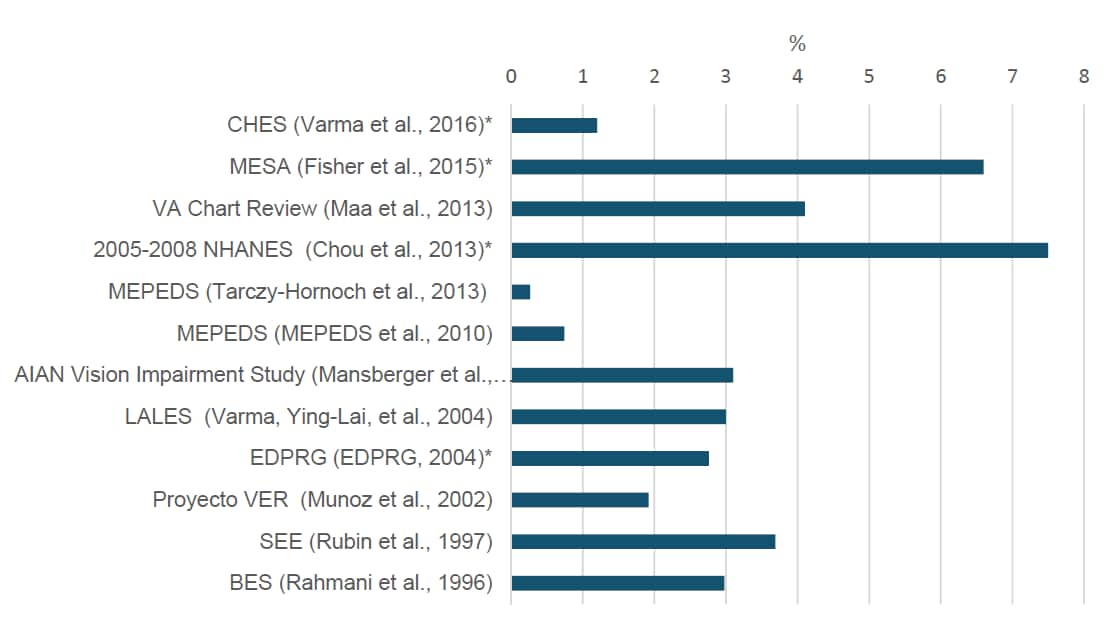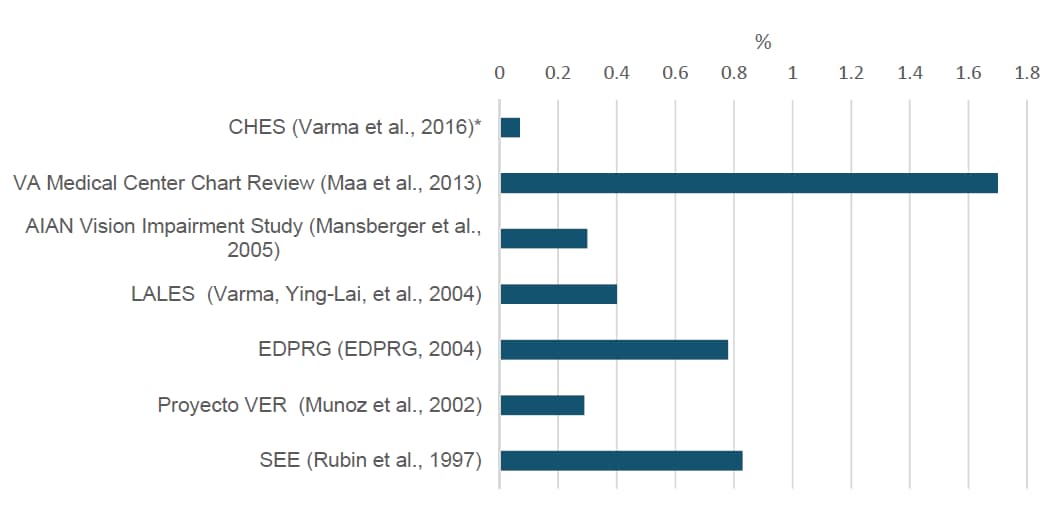Review: Vision Impairment and Blindness
‹View Table of Contents
The VEHSS team conducted a review of published literature on examination-based population studies reporting the prevalence of vision impairment and blindness.
Vision impairment (VI) is generally determined by measuring the best-corrected visual acuity (BCVA) of the better-seeing eye. Most studies in the United States measure visual acuity at a distance of 20 feet using the standardized Snellen Eye Chart.(Segre, 2015) Autorefractors may also be used to assess visual acuity and to estimate lens prescription. BCVA is a person’s best distance vision while using optimal refraction correction (eye glasses, contact lenses, laser surgery).(Segre, 2015) There is no universal definition of visual impairment and there are varying definitions of BCVA, including 20/40 to 20/63 (mild VI), 20/80 to 20/160 (moderate VI), 20/200 or worse (severe VI).(Varma, 2004) Legal blindness is defined by the US government (to determine eligibility for vocational training, rehabilitation, schooling, disability benefits, low vision devices, and tax exemption programs) as 20/200 or worse, and by the World Health Organization as 20/400 or worse.
Download the full report:
Published Examination-Based Prevalence of Major Eye Disorders [PDF – 703 KB]
Vision Impairment and Blindness Literature Review Results
There were 12 studies published between 1995 and 2016 that examined the prevalence of vision impairment and blindness.
Table 1. Vision Impairment and Blindness Prevalence Sources.
| Author | Date of Publication | Title | Date of Data Collection | Data Source | Sample Size | Prevalence Data Stratified by: |
|---|---|---|---|---|---|---|
| Varma R, Choudhury F, et al. | 2016 | Prevalence and Causes of Visual Impairment and Blindness in Chinese American Adults: The Chinese American Eye Study | 2010–2013 | CHES | 4,582 | Race, Age, Sex |
| Fisher DE, Shraqer S, et al. | 2015 | Visual Impairment in White, Chinese, Black, and Hispanic Participants from the Multi-Ethnic Study of Atherosclerosis Cohort | 2002–2004 | MESA | 6,134 | Age, Sex, Race / Ethnicity |
| Maa AY, Evans C, et al. | 2013 | Veteran Eye Disease After Eligibility Reform: Prevalence and Characteristics | January 2008–February 2008 | Atlanta VA Medical Center Chart Review | 658 | Not stratified by demographic variables |
| Chou, C.F., Cotch, M.F., Vitale, S., et al. | 2013 | Age-Related Eye Diseases and Visual Impairment Among US Adults | 2005–2008 | NHANES | 5,222 | Age |
| Klein R, Lee KE, et al. | 2009 | Changes in Visual Impairment Prevalence by Period of Diagnosis of Diabetes: The Wisconsin Epidemiologic Study of Diabetic Retinopathy | 1980–2007 | WESDR | Various | Not stratified by demographic variables |
| Mansberger SL, Romero FC, et al. | 2005 | Causes of Visual Impairment and Common Eye Problems in Northwest American Indians and Alaska Natives | Unknown | Northwest AIAN | 288 | Not stratified by demographic variables |
| Varma R, Ying-Lai M, Klein R, Azen SP, et al. | 2004 | Prevalence and Risk Indicators of Visual Impairment and Blindness in Latinos: the Los Angeles Latino Eye Study. | 2000–2008 | LALES | 6,122 | Race / Ethnicity, Sex, Age |
| The Eye Diseases Prevalence Research Group | 2004 | Causes and Prevalence of Visual Impairment Among Adults in the United States | 1985–1998 | EDPRG | Various | Age, Race / Ethnicity, Sex |
| Muñoz B, West SK, Rodriguez J, et al. | 2002 | Blindness, Visual Impairment and the Problem of Uncorrected Refractive Error in a Mexican-American Population: Proyecto VER. | 1997–1999 | Proyecto VER | 4,774 | Age, Sex, Race / Ethnicity |
| Rubin GS, West S, et al. | 1997 | A Comprehensive Assessment of Visual Impairment in a Population of Older Americans. The SEE Study. Salisbury Eye Evaluation Project | 1993–1995 | The SEE Project | 2,520 | Age, Sex, Race |
| Rahmani B, Tielsch JM, et al. | 1996 | The Cause-Specific Prevalence of Visual Impairment in an Urban Population. The Baltimore Eye Survey | 1985–1988 | BES | 5,300 | Age, Sex, Race |
| Klein R, et al. | 1995 | The Relationship of Age-Related Maculopathy, Cataract, and Glaucoma to Visual Acuity | 1988–1990 | BDES | 4,886 | Age |
Overall Vision Impairment and Blindness Prevalence Rates
Figure 1 shows the estimated total population prevalence rate for vision impairment derived from selected studies. Overall visual impairment prevalence rates ranged from 0.27% in MEPEDs to 7.5% in the 2005–2008 NHANES, which included older adults. Figure 2 reports blindness prevalence from selected studies. Overall, blindness prevalence rates ranged from 0.07% in CHES to 1.7% in the Atlanta VA Medical Center Chart Review. These studies identified and compared vision impairment and blindness prevalence rates across race/ethnicity, age, education level, and income.
The high degree of variation among the results in each figure is likely due to in part to methodological, disease definition, and population differences among the studies. These figures are intended to illustrate the range of published prevalence values; direct comparison of the studies is impossible without considering the underlying differences in the studies. Detailed results from each individual study are available in the full report “Published Examination-based Prevalence of Major Eye Disorders.”
Figure 1. Overall Vision Impairment Prevalence Rates in Selected Studies.

*Age- or population- adjusted prevalence rate.
Figure 2. Overall Blindness Prevalence Rates in Selected Studies**.

*Adjusted prevalence rate.
**Blindness is defined by the U.S. government definition of best-corrected visual acuity of 20/200 or worse.